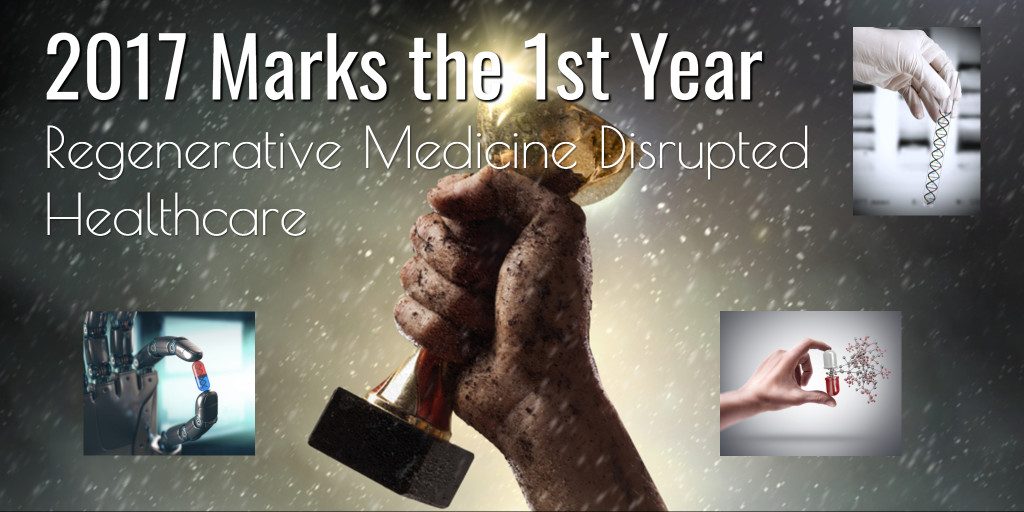The regenerative medicine industry has been rapidly expanding over the past few years, making it a high-value, fast-growth market. Key drivers for the market include high rates of clinical trials, accelerated pathways for product approvals, new technologies to support cell and gene therapy manufacturing, and the potential for cell therapies to revolutionize healthcare.
The regenerative medicine market gained major momentum when the Swiss pharmaceutical giant Novartis made history as the first company to win FDA approval for a CAR-T cell therapy in the U.S. in August 2017 (Kymriah). In October 2017, Kite Pharma became the second company to get FDA approval of a CAR-T cell therapy (Yescarta).
With swelling momentum to support the CAR-T technology, there are now close to 40 companies developing redirected T cells or NK cells for therapeutic use.
On November 13, 2017, the FDA approved Abilify MyCite as the world’s first “digital pill.” With 7 out of 10 Americas taking at least one prescription drug, approval of the antipsychotic medication represents a breakthrough in digital medicine. Made by Japan-based Otsuka Pharmaceutical, the tablet works by containing a sensor to track when and if patients take their medication.
On December 19th, 2017, the FDA approved Spark Therapeutics’ Luxturna, a novel gene therapy to treat patients with an inherited form of vision loss.
Jaw-Dropping Evidence in Support of Regenerative Medicine
In addition to product approvals, there are now accelerated pathways for advanced therapy medicinal products (ATMPs) in several countries worldwide, including the U.S., Japan, and South Korea. Legislation took effect in Japan in late 2014, in South Korea in 2016, and in the United States in 2017. Additionally, the EU has a program for product acceleration – the Adaptive Pathways. Although it is not explicitly for cell and gene therapies, it has been given a lot of attention by the group.
These historic events demonstrate to investors, the public, and funding providers alike that regenerative medicine is a sector that has emerged, no longer one that is evolving in the future.
“Big Pharma” is also demonstrating snowballing interest in regenerative medicine. At its core, this is a strategic way for pharmaceutical companies to diversity their product development pipeline. In recent examples:
- Takeda Pharmaceutical Company announced its intent to acquire TiGenix for €520m in January 2018. TiGenix is exploring ant-inflammatory properties of allogeneic stem cells (lead product, Cx601).
- Gilead announced December 2017 that it is acquiring Cell Design Labs, a biotech company developing novel CAR-T and T cell receptor therapies in a deal valued at up to $567 million.
- Johnson & Johnson is paying $350 million upfront to partner with Chinese firm Nanjing Legend Biotech. As a result of the December 2017 deal-making, J&J’s biotech unit (Janssen) will get a global license to commercialize LCAR-B38M in multiple myeloma.
- Japanese drugmaker Otsuka Holdings acquired a 10% (1 billion yen) stake in Megakaryon, a venture that creates platelets out of induced pluripotent stem cells in December 2017.
- Amgen Ventures participated in Fortuna Fix’s USD $25 million Series B financing in November 2017. Fortuna fix is using its direct reprogramming technology to repair neural tissue.
- Astellas Pharma funded a development program with Universal Cells to utilize its Universal Donor Cell Technology in October 2017.
- Gilead Sciences acquired Kite Pharma in August 2017 for $11.9B, thereby securing access to Kit’es lead CAR T therapy candidate, Yescarta (Axicabtagene Ciloleucel), which was approved by the FDA in October 2017.
- Hitachi Chemical bought PCT cell therapy, a cell therapy CDMO, in May 2017.
- FUJIFILM purchased a 10% equity stake in January 2017 in Cynata Therapeutics, the company responsible for the world’s first clinical trial worldwide involving an allogeneic iPSC-derived therapeutic product (CYP-001).
- Bayer AG spun off BlueRock Therapeutics with funding of $225 million in December 2016.
Finally, direct cell reprogramming is gaining momentum. Fortuna Fix, a company specializing in direct cell reprogramming applications to restore neuronal functionality, secured $25 million in Series B financing. The proceeds will enable the company to conduct Phase I/IIa clinical trials in Parkinson’s Disease and Spinal Cord Injury.
The Brave and Bold Pioneers
Over the past 12-months, regenerative medicine has accelerated as a “movement.” With more than 600+ brave companies now composing the marketplace, immunotherapies, gene therapy, and digital medicine have introduced true disruption of healthcare.
Today, the regenerative medicine industry includes companies that are developing:
- Stem cell therapies
- Cellular immunotherapies
- Direct cell reprogramming
- Exosome therapies
- Cellular scaffolds and matrices
- Gene therapies
- Tissue engineering and biomaterials
- 3D bioprinting
- Biomaterials
Interested to learn more about the industry? We spent exhaustive hours uncovering 600+ companies across the globe that are developing regenerative medicine therapeutics for use in humans.
